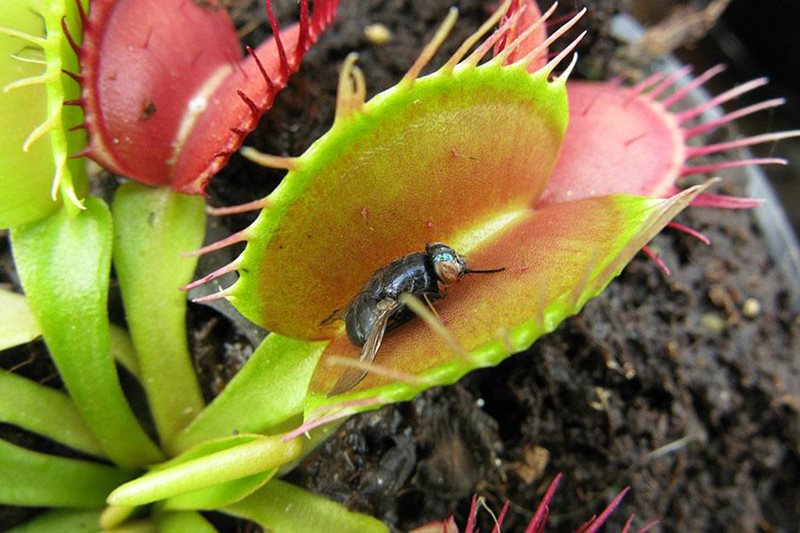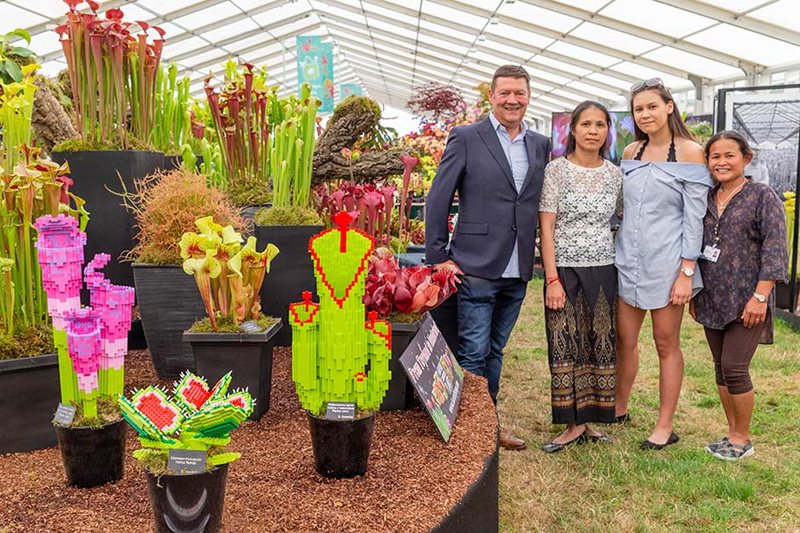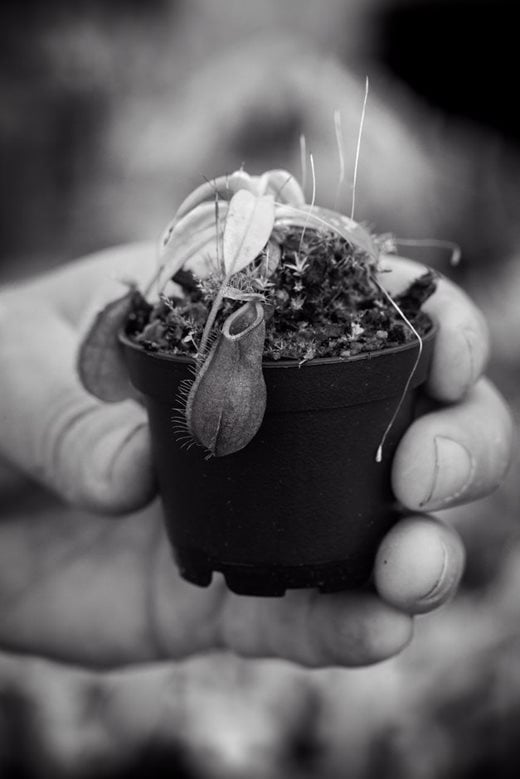Master Grower: Hampshire Carnivorous Plants
Carnivorous plants hold a certain fascination, as our Hampton Court Master Grower 2018 explained
The rise of carnivorous plants
Carnivorous plants have the ability to fascinate young and old, often igniting a spark of curiosity that leads to a lifelong passion for growing plants. Although many originate from regions as diverse as Mexico, Alaska, Australia and tropical Asia, there are plenty that can be successfully grown in the UK, often requiring little specialist knowledge. Carnivorous plants have clever ways of catching and feeding on living organisms, using traps, pitchers and sticky pads to harvest their prey.
The rise in popularity of insect-eating plants is likely to be linked to changes in British lifestyle, with more city-dwellers living in flats with no garden or outdoor space. This is leading to a revival in the fortunes of houseplants such as cacti and succulents as Millennials seek foliage to furnish their first homes, but the message is spreading that carnivorous plants can easily be grown on a bright windowsill, often requiring little more than a saucer of rainwater to sit in.
At the forefront of the revival is Hampshire Carnivorous Plants, run by Matthew Soper, a lifelong enthusiast of insect-eating plants. Matthew’s nursery offers the all-popular Venus fly trap (Dionaea muscipula) as well as in-demand carnivorous plants such as Nepenthes, Sarracenia and Drosera, to name a few. With more than 20 years’ experience on the flower show circuit, Hampshire Carnivorous Plants was chosen as our Master Grower for the RHS Hampton Court Palace Flower Show 2018. Matthew’s extensive range includes hybrids that originated from his nursery’s own breeding programme, with insect-eaters offered for windowsill, greenhouse and garden cultivation.

Best of the bunch – Matthew’s top five carnivorous plants
One of Matthew’s hybrids bearing vivid pink colour throughout summer. Plants produce pitchers in spring, followed by a second crop of pitchers in late-August to September, which are bigger than those borne earlier in the season. Pitchers are retained into autumn. This pitcher plant holds an RHS Award of Garden Merit (AGM) and will thrive if stood in a tray of rainwater from March to October, in a bright, sunny position. During winter, keep plants slightly damp and cool and remove any dead foliage. Matthew says: “It is an excellent hybrid for people who are starting out growing carnivorous plants. I named it for my wife.”
Better known as the Venus fly trap, it’s the most popular carnivorous plant in the UK, fascinating children with its jaw-like, fly-catching traps. The key to success is to remove flowers in spring, because blooms can weaken the plant. Venus fly traps do well on a sunny windowsill or frost-free greenhouse where they’ll appreciate standing in a saucer of rainwater from March to September. Although it is tempting, don’t make the plant’s traps shut artificially or force-feed plants, because they don’t appreciate interference. During winter, plants go into dormancy and lose most of their foliage. Keep them in a cooler position with compost just damp, and remove any dead foliage.
One of the easiest carnivorous plants for first-time growers and children, the Cape Sundew is sold in a number of forms, with ‘All-Red’ being popular, as well as the white-flowering ‘Alba’ and a narrow-leaf version, too. It’s said to be easier and faster-growing than the Venus flytrap: just stand plants in a tray of rainwater in a bright, sunny position in spring and summer. Drosera capensis is tough and can be kept in an unheated greenhouse over winter, tolerating temperatures as low as -5C (23F). Plants have an appetite for feeding on whitefly and can be used as an environmentally friendly pest control to keep aphid numbers down in greenhouses and conservatories.
An excellent insect-eating plant to grow outdoors all year-round, thriving in peaty bog gardens, but will be at home in an unheated greenhouse. Noted for its dark red-and-green veined pitchers and red flowers in spring, this hybrid must be kept cold over winter to allow it to rest, tolerating temperatures as low as -25C (-13F). “It is extremely hardy and looks so exotic,” Matthew points out.
A “slow-growing but rewarding” carnivorous plant endemic to Borneo that’s suited to more experienced growers. It bears contrasting purple and green pitchers but needs to be grown in a warm, humid environment. Plants need a daytime temperature of 18-20C (64-68F) and a minimum night temperature of around 10C (50F). For optimum growth, keep plants damp rather than wet and apply a weak liquid feed as a foliage feed every one to two weeks.

About Hampshire Carnivorous Plants – our RHS Hampton Court Master Grower
Matthew Soper’s passion for carnivorous plants started when he was just seven years old and first caught sight of a Venus fly trap while watching a natural history programme on television: “It sparked my interest in growing plants and quickly turned into a hobby. I grew carnivorous plants in my dad’s 8x10ft tomato greenhouse and started to expand my collection,” Matthew explains.
Although Matthew became builder by trade, his horticultural hobby was destined to shape his future career because, in 1993, he started selling insect-eating plants and developed a nursery that’s now a household name on the flower show circuit. To date, Hampshire Carnivorous Plants has been awarded more than 100 RHS gold medals and, since the year 2000, has won best-in-show awards at Gardening Scotland, the Malvern Autumn Show, BBC Gardeners’ World Live, RHS Tatton Park and the National Amateur Gardening Show.
Four years ago, the nursery expanded with a move to a new site near Winchester, where carnivorous plants are nurtured in a quarter-acre Venlo glasshouse. Plants get uninterrupted sunlight from sunrise to sunset – a real bonus for Sarracenia and Venus fly traps, as high light levels enhance their colour during the growing season. As Master Grower for Hampton Court, Matthew is looking forward to sharing his expert knowledge and enthusiasm with new and experienced gardeners alike.
Hampshire Carnivorous Plants: Timeline:
 1993 – Matthew Soper was still growing carnivorous plants as a hobby, but started selling plants for the first time, initially to friends and family.
1993 – Matthew Soper was still growing carnivorous plants as a hobby, but started selling plants for the first time, initially to friends and family.- 1996 – First exhibit at a flower show, winning a gold medal at the Southampton Flower and Balloon Festival.
- 1999 – Hampshire Carnivorous Plants puts on its first exhibit at the RHS Chelsea Flower Show and wins an RHS gold medal.
- 2004 – Winner of the prestigious Tudor Rose Award at the RHS Hampton Court Palace Flower Show, a success that was repeated in 2010 and 2011.
- 2014 – A major expansion as the nursery moves to new premises, providing a quarter of an acre of glass on a greenfield site at Lower Upham, near Winchester.
- 2016 – Awarded Best in Show for the third time at the Malvern Autumn Show.
- 2018 – Winner of the prestigious Anthony Huxley Trophy at the RHS Annual Awards. Announced as Master Grower for the RHS Hampton Court Palace Flower Show.

